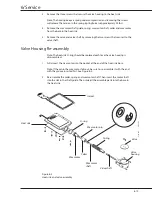
6/Service
6-7 6-7
Heater Current Sense Circuit
The heater current sense circuit consists of L27, JP1, D3, and R6. Alternating current
through JP1, which is the heater current line, generates an alternating current in
inductor L27. The current from L27 is half wave rectified by diode D3 and applied to
load R6. For 115V~ applications, the voltage at R6 is approximately 600 mV. For
230V~ applications, the voltage at R6 is approximately 300 mV. The voltage across
R6 is applied to ADC1 (pin 4 of the microcontroller).
Add Water Circuit
Understanding the add water circuit assumes a working knowledge of the heater circuit.
The heater circuit consists of a heater in series with a non-resettable thermal fuse and
a resettable thermostat (refer to wiring diagram drawing number 6600-1820-100). The
thermostat is designed to open prior (at a lower temperature) to the thermal fuse
opening. As the water level decreases, the temperature of the heat sink increases.
This process will occur until the setting of thermostat is reached. When the thermostat
opens, the microcontroller will sense no current via the Heater Current Sense Circuit.
In order to confirm that the thermostat opened (as opposed to the thermal fuse), the
microcontroller has another sense input, P3.7 (pin 17). This sense circuit consists
of R64, R9, U2. One side of the opto-isolator, U2, pin 1, is connected to phase side,
through R64 and R9, of the AC line. Resistors R64 and R9 limit the amount of current
through U2. The other side of U2, pin 2, is connected to the junction of the thermal
fuse and the thermostat.
Under normal conditions, the thermostat is closed, completing the AC circuit. During
the positive half cycle, current flows through R64, R9, internal diode of U2, and the
thermostat. When the internal diode of U2 is forward biased, the output transistor is
turned on, causing the P3.7 sense line to be pulled low. When the internal diode of
U2 is reverse biased, the output transistor is turned off. The pull up resistor, R5, causes
the P3.7 sense line to go high. This process causes the output of U2 to pulse at the
same frequency as the AC line.
When the water is low, the thermostat opens. The AC circuit is open so no current
can flow through the input of U2. The output transistor of U2 remains off and the P3.7
sense line remains high. Diode D2 is placed across the input to the opto-isolator in the
opposite direction as the internal diode in the opto-isolator to limit the voltage across
the input of U2 to 700mV when the internal diode is reverse biased. This prevents the
opto-isolator from seeing over-voltage.
The output stage of the opto-isolator incorporates a photo diode and a linear amplifier.
Pins 5 and 6 are ground and Vcc, respectively, for the amplifier.
The final output stage (pin 4) of the opto-isolator is configured as an open collector.
The output (pin 4) of U2 is connected directly to the P3.7 line (pin 17) of the
microcontroller. The line is pulled high by R5 to provide proper signal levels.
Содержание Ohio Care Plus
Страница 20: ...2 General Information 2 4 2 4 Notes...
Страница 24: ...4 Using the Servo controlled Humidifier 4 2 4 1 Notes...
Страница 46: ...6 Service 6 18 6 18...
Страница 53: ...8 Schematics 8 1 Figure 8 1 Wiring Diagram Servo controlled Humidifier 8 Schematics CI 18 059...
Страница 54: ...8 Schematics 8 2 Figure 8 2 Power Supply section of the Control Display Board Assembly CI 18 060...
Страница 55: ...8 Schematics 8 3 Figure 8 3 Digital section of the Control Display Board Assembly CI 18 061...
Страница 56: ...8 Schematics 8 4 Figure 8 4 Analog section of the Control Display Board Assembly CI 18 062...
Страница 57: ...8 Schematics 8 5 Figure 8 5 Heater Control section of the Control Display Board Assembly CI 18 063...
Страница 58: ...8 Schematics 8 6 Figure 8 6 Display section of the Control Display Board Assembly CI 18 064...
Страница 67: ......
















































